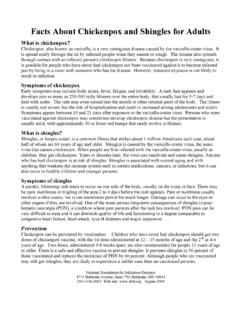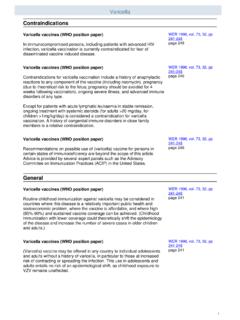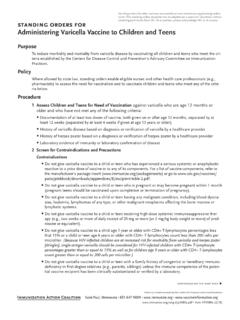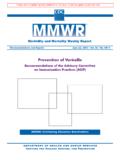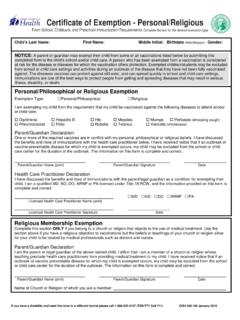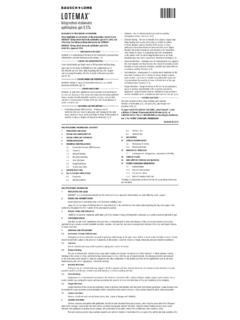Transcription of Immunization of Health-Care Workers
1 TM December 26, 1997 / Vol. 46 / No. RR-18 Recommendations and Reports Immunization of Health-Care Workers Recommendations of the Advisory Committee on Immunization Practices (ACIP) and the Hospital Infection Control Practices Advisory Committee (HICPAC) DEPARTMENT OF health AND HUMAN SERVICES Centers for Disease Control and Prevention (CDC) Atlanta, Georgia 30333 The MMWR series of publications is published by the Epidemiology Program Office, Centers for Disease Control and Prevention (CDC), Department of health and Hu man Services, Atlanta, GA 30333. SUGGESTED CITATION Centers for Disease Control and Prevention. Immunization of Health-Care Work ers: recommendations of the Advisory Committee on Immunization Practices (ACIP) and the Hospital Infection Control Practices Advisory Committee (HICPAC).
2 MMWR 1997;46(No. RR-18):[inclusive page numbers]. Centers for Disease Control and David Satcher, , Director The material in this report was prepared for publication by: National Immunization Program ..Walter A. Orenstein, Director Epidemiology and Surveillance Division .. Stephen C. Hadler, Director The production of this report as an MMWR serial publication was coordinated in: Epidemiology Program Stephen B. Thacker, , Director Richard A. Goodman, , Editor, MMWR Series Office of Scientific and health Communications (proposed) Recommendations and Suzanne M. Hewitt, Managing Editor Robert S. Black, Project Editor Peter M. Jenkins Visual Information Specialist Use of trade names and commercial sources is for identification only and does not imply endorsement by the Department of health and Human Services. Copies can be purchased from Superintendent of Documents, Government Printing Office, Washington, DC 20402-9325.
3 Telephone: (202) 512-1800. Introduction ..1 Background ..3 Diseases for Which Immunization Is Strongly Recommended ..3 Hepatitis B ..3 Influenza ..10 Measles, Mumps, and Tuberculosis and Bacille-Calmette-Gu rin Vaccination ..13 Control of TB ..14 Role of BCG Vaccination in Prevention of TB Among HCWs ..14 Hepatitis C and Other Parenterally Transmitted Non-A, Non-B Other Diseases for Which Immunization of Health-Care Workers Is or May Be Hepatitis A ..17 Meningococcal Disease ..17 Pertussis ..18 Typhoid ..19 Vaccinia ..20 Other Vaccine-Preventable Diseases ..20 Immunizing Immunocompromised Health-Care Workers ..20 Corticosteroid Therapy ..20 HIV-Infected Immunization Is Strongly Recommended ..22 Hepatitis B ..22 Influenza ..24 Measles, Mumps, and Hepatitis C and Other Parenterally Transmitted Non-A, Non-B Other Diseases for Which Immunoprophylaxis Is or May Be Tuberculosis and BCG Vaccination of Health-Care Workers in High-Risk Settings.
4 26 Hepatitis A ..27 Meningococcal Disease ..27 Pertussis ..28 Typhoid ..28 i Vol. 46 / No. RR-18 MMWR Contents Vaccinia ..28 Other Vaccine-Preventable Diseases ..28 Tetanus and Pneumococcal Immunization of Immunocompromised Health-Care Workers ..29 HIV-Infected Other Considerations In Vaccination Of Health-Care Immunization Catch-Up Vaccination Programs ..31 Work Restrictions for Susceptible Workers After Outbreak Control ..32 Vaccines Indicated for Foreign ii MMWR December 26, 1997 iii Vol. 46 / No. RR-18 MMWR The following CDC staff members prepared this report: Walter W. Williams, , Raymond A. Strikas, Epidemiology and Surveillance Division National Immunization Program Miriam J. Alter, , Division of Viral and Rickettsial Diseases National Center for Infectious Diseases iv MMWR December 26, 1997 1 Vol.
5 46 / No. RR-18 MMWR Immunization of Health-Care Workers : Recommendations of the Advisory Committee on Immunization Practices (ACIP) and the Hospital Infection Control Practices Advisory Committee (HICPAC) Summary This report summarizes recommendations of the Advisory Committee on Im munization Practices (ACIP) concerning the use of certain immunizing agents in Health-Care Workers (HCWs) in the United States. It was prepared in consultation with the Hospital Infection Control Practices Advisory Committee (HICPAC) and is consistent with current HICPAC guidelines for infection control in Health-Care personnel. These recommendations can assist hospital administrators, infection control practitioners, employee health physicians, and HCWs in optimizing in fection prevention and control programs. Background information for each vaccine-preventable disease and specific recommendations for use of each vac cine are presented.
6 The diseases are grouped into three categories: a) those for which active Immunization is strongly recommended because of special risks for HCWs; b) those for which immunoprophylaxis is or may be indicated in certain circumstances; and c) those for which protection of all adults is recommended. This report reflects current ACIP recommendations at the time of publication. ACIP statements on individual vaccines and disease updates in MMWR should be consulted for more details regarding the epidemiology of the diseases, im munization schedules, vaccine doses, and the safety and efficacy of the vaccines. INTRODUCTION Because of their contact with patients or infective material from patients, many Health-Care Workers (HCWs)( , physicians, nurses, emergency medical personnel, dental professionals and students, medical and nursing students, laboratory techni cians, hospital volunteers, and administrative staff) are at risk for exposure to and possible transmission of vaccine-preventable diseases.
7 Maintenance of immunity is therefore an essential part of prevention and infection control programs for HCWs. Optimal use of immunizing agents safeguards the health of Workers and protects pa tients from becoming infected through exposure to infected Workers (Table 1) (1 15 ). Consistent Immunization programs could substantially reduce both the number of susceptible HCWs in hospitals and health departments and the attendant risks for transmission of vaccine-preventable diseases to other Workers and patients (16 ). In addition to HCWs in hospitals and health departments, these recommendations apply to those in private physicians offices, nursing homes, schools, and laboratories, and to first responders. Any medical facility or health department that provides direct patient care is en couraged to formulate a comprehensive Immunization policy for all HCWs.
8 The American Hospital Association has endorsed the concept of Immunization programs 2 MMWR December 26, 1997 TABLE 1. Recommendations for Immunization practices and use of immunobiologics applicable to disease prevention among Health-Care Workers Advisory Committee on Immunization Practices (ACIP) statements published as of September 1, 1997 Subject MMWR Publication General recommendations on Immunization 1994;43( ):1-39 Adult Immunization 1991;40( ):1-94 Altered immunocompetence 1993;42( ):1-18 Adverse reactions, contraindications, and precautions 1996;45( ):1-35 Bacille Calmette-Gu rin vaccine 1996;45( ):1-18 Diphtheria, tetanus, and pertussis 1991;40( ):1-28 1997;46(No. RR-7) Hepatitis B 1991;40( ):1-25 Hepatitis A 1996;45( ):1-30 Influenza* 1997;46( ):1-25 Japanese encephalitis 1993;42( ):1-15 Measles 1989;38( ):1-18 Measles, mumps, rubella (MMR) 1998;47 (in press) Meningococcal disease and outbreaks 1997;46( ):1-21 Mumps 1989;38:388 92, 397 400 (MMR in press, see Measles above) Pertussis, acellular 1992;41( ):1-10 (see also Diphtheria above) 1992;41( ):1-5 (supplementary statements) 1997;46( ):1-25 Pneumococcal 1997;46( ):1-24 Poliomyelitis 1997;46( ):1-25 Rabies 1991;40( ):1-19 Rubella 1990;39( ):1-18 (MMR in press, see Measles above) Typhoid 1994;43( ):1-7 Vaccinia (smallpox) 1991;40( ):1-10 Varicella 1996.
9 45( ):1-36 *Each year influenza vaccine recommendations are reviewed and amended to reflect updated information concerning influenza activity in the United States for the preceding influenza season and to provide information on the vaccine available for the upcoming influenza season. These recommendations are published annually in the MMWR, usually during May or June. for both hospital personnel and patients (17 ). The following recommendations con cerning vaccines of importance to HCWs should be considered during policy development (Table 2). 3 Vol. 46 / No. RR-18 MMWR BACKGROUND Diseases for Which Immunization Is Strongly Recommended On the basis of documented nosocomial transmission, HCWs are considered to be at significant risk for acquiring or transmitting hepatitis B, influenza, measles, mumps, rubella, and varicella.
10 All of these diseases are vaccine-preventable. Hepatitis B Hepatitis B virus (HBV) infection is the major infectious hazard for Health-Care per sonnel. During 1993, an estimated 1,450 Workers became infected through exposure to blood and serum-derived body fluids, a 90% decrease from the number estimated to have been thus infected during 1985 (18 20 ). Data indicate that 5% 10% of HBV-infected Workers become chronically infected. Persons with chronic HBV infection are at risk for chronic liver disease ( , chronic active hepatitis, cirrhosis, and primary hepatocellular carcinoma) and are potentially infectious throughout their lifetimes. An estimated 100 200 Health-Care personnel have died annually during the past decade because of the chronic consequences of HBV infection (CDC, unpublished data). The risk for acquiring HBV infection from occupational exposures is dependent on the frequency of percutaneous and permucosal exposures to blood or body fluids con taining blood (21 25 ).










